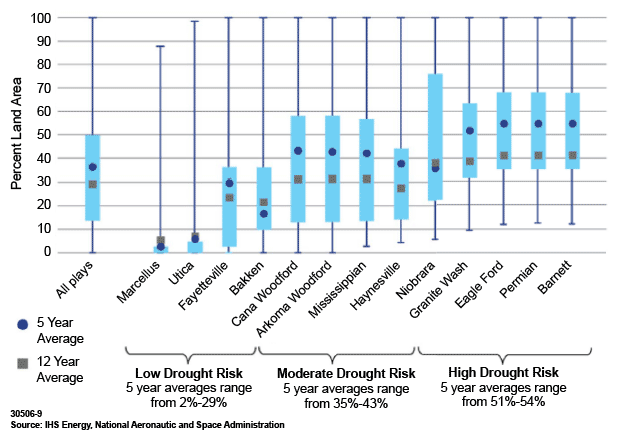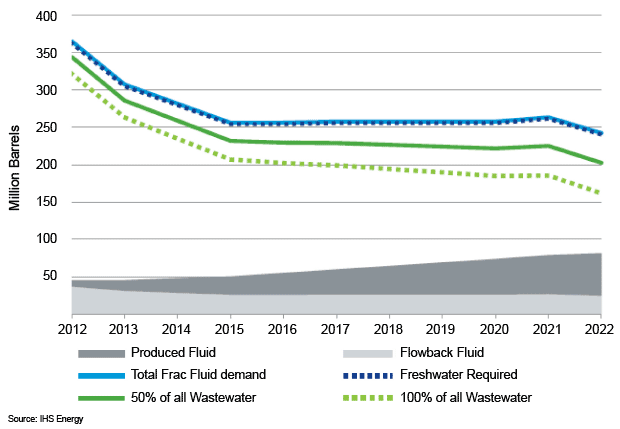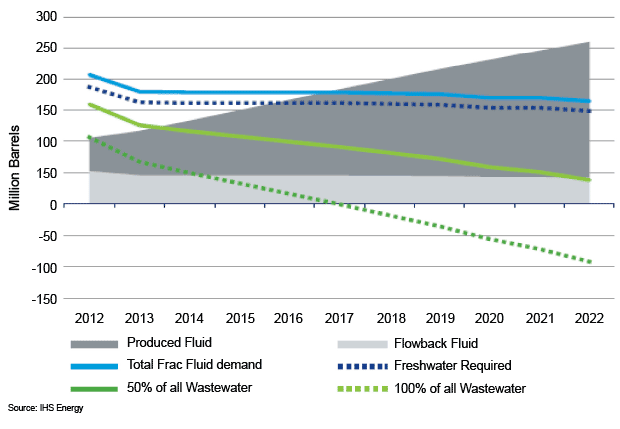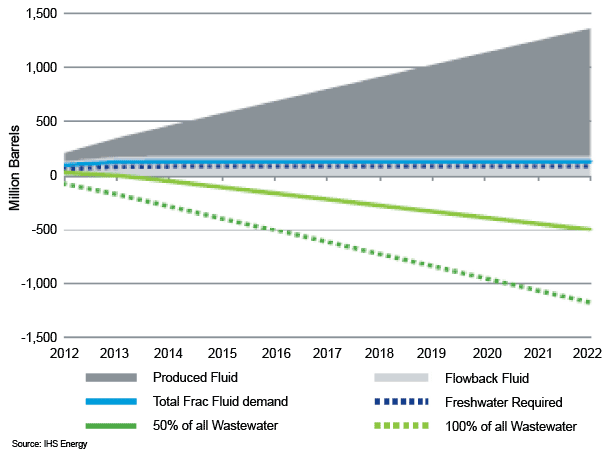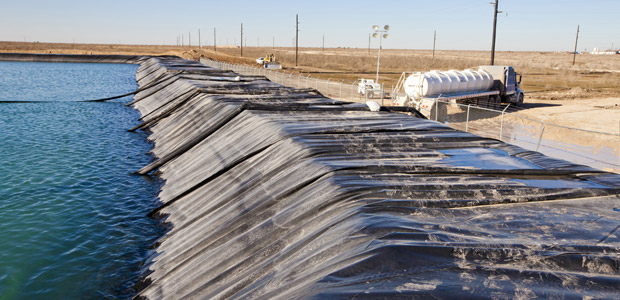
Hydraulic Fracturing
Strategies Assure Water Availability
By Marcus Oliver Gay and Sarah Fletcher
HOUSTON–Water is a critical component in the drilling and completion process for unconventional oil and gas wells, and disruptions in access to water supplies pose a significant operational and financial risk to operators.
While the United States is typically considered a relatively water-rich country, many areas face increasing drought risk, especially in the western half of the country. Water is a highly localized problem, with competition for water resources for domestic, commercial and industrial use managed at the state, and increasingly, local levels. Oil and gas operators in high-activity unconventional plays face unique resource availability, competition for access, regulation, and community sentiment around water use.
Water used for oil and gas development is equal to only 0.2 percent of water used for agriculture on an annual basis in the United States, but oil and gas water use can account for up to 30 percent of total water use in some water-stressed counties in Texas. In such areas, where operators face high competition for and low availability of water resources, oil and gas companies may have to rely on more expensive sources of water in order to ensure a reliable supply.
More expensive sources include deep freshwater aquifers, brine aquifers producing higher salinity water, and drought-tolerant water supplies farther away from the well site that can require significant infrastructure investments to access. These more expensive options can raise the total cost of water management by as much as 50 percent. Alternatively, operators can choose to source water by reusing flow back fluid and produced fluid from their own operations.
While increased water management costs are a burden to oil and gas companies, the risk to operations and well productivity from water stress is much more impactful. If water supply chain disruptions prevent well drilling and completion, the delays can be costly. Alternatively, if the operator decides to use less water than specified in the completion design, the productivity of a well can be compromised.
In its second-quarter 2012 earnings, Devon Energy reported significant losses to production as a result of using smaller-sized frac jobs because of regional drought conditions in Texas. At times of water stress, the financial risk of operational delays and productivity declines is measured in billions of dollars.
Given the risks from water stress, it is critical for operators to understand the water stress indicators as well as water demand requirements for the industry at the individual play level in order to implement water management strategies that avoid or mitigate the consequences. Implementing operational best practices and investing in water-related infrastructure are equally important to offset water risk in onshore exploration and development activity.
Play-Level Water Stress Risk
The total water resources available depend on water availability and competition for water use. Assessing these factors on the play level helps operators determine how much water is likely to be accessible for oil and gas operations. In areas with high total water resources where current demand is less than 20 percent of total resources–that is, areas that are not water stressed–it is unlikely that operators will routinely face challenges sourcing water. In areas that are water stressed, a state’s regulatory system is critical to determining how operators can access water resources.
In many western states that have a prior appropriation system for surface water and sometimes groundwater resources, only the most senior rights holders are allocated water during times of shortages. Typically, senior water rights are held by farmers and are difficult and expensive for new oil and gas operators to obtain. This means that operators in these areas should look to alternative methods such as using brine aquifers or purchasing leftover water sources from municipalities and farmers.
Droughts occur because of natural variations in weather patterns and can affect areas that are not typically water stressed. For example, summertime droughts have caused the Susquehanna River Basin Commission in the Marcellus Shale region to restrict withdrawals to oil and gas operators even though the area is not typically water stressed. Droughts, however, are usually more frequent and more devastating in areas that are routinely water stressed.
Moreover, droughts pose the greatest risk to operators’ water supply chains because of the inherent uncertainty. While annual water stress can help an operator choose a water source that is likely to be secure, the natural volatility that causes droughts can lead to unexpected and costly disruptions in an operator’s supply chain for water as a key resource.
An analysis of drought data from the National Oceanic and Atmospheric Administration (NOAA) to assess play-level water stress, combined with data on completion activity, shows that 79 percent of completion activity is taking place in areas that have faced moderate or high drought risk over the past 10 years. Figure 1 shows the land area in 13 high-activity unconventional plays impacted by drought.
Projected Water Demand
Water availability is one side of the equation; the other side is demand from oil and gas activity. Using IHS drilling and completion data for the 13 high-activity unconventional resource plays from 2012 through 2022, we estimate that 1.8 billion barrels of fluid are required to support current annual completion activity. While the oil and gas industry is often identified as a large user of water, its use is equivalent to approximately 0.2 percent of the total irrigation water used each year bythe U.S. agricultural sector.
However, as the drought analysis in Figure 1 demonstrates, water supply risk is often localized to small areas over short periods. Marginal increases in water demand in areas that are already water stressed can impact other water users by increasing the frequency and severity of shortages. Therefore, water demand analysis at the play level (especially in play areas facing high drought risk) is more meaningful than at the national level. Figures 2, 3 and 4 show water use projections through 2022 for the Eagle Ford Shale, Bakken Shale and Mississippian Lime plays, respectively.
The Eagle Ford is expected to have one of the highest demands for fracture fluid. While it does not have the highest annual completion rate, a high percentage of the new wells are horizontal wells that require large water volumes for hydraulic fracturing. The overall annual fracture fluid demand will decrease modestly over the next 10 years due to a declining number of wells being completed. By 2022, fracture fluid demand in the Eagle Ford is projected to require more than 240 million barrels of water, second only to the Permian Basin.
Further analysis shows that there is little potential to substantially mitigate this demand with wastewater recycling, as the total volumes of flow back and produced water generation are only a fraction of the volumetric water demand throughout the 10-year period. However, the region’s supply of fresh and brackish groundwater present a reliable source that may be resistant to the impact of drought throughout the projected timeframe.
In contrast to the Eagle Ford, the required fracture fluid volume in the Permian is less than a quarter of the volume of wastewater generated in the play. Wastewater in the Permian is heavily dominated by produced water from a long established base of producing wells in conventional resources. At the macro level within the Permian, there are ample wastewater supplies available to reduce source water requirements, but the quality is very poor and much of this fluid may already be accounted for by existing secondary recovery techniques within conventional fields. This means that reducing source water requirements by a notable percentage would require significant water treatment or fracture chemical modification, posing an expense to operators.
Alternative Supply Sources
Given the industry’s growing demand for water, combined with the increasing risk of water scarcity in many already water-stressed areas of the country, operators are increasingly looking to alternative water sources. While some of these sources have higher costs than traditionally sourced freshwater, the mitigation of supply chain risk often makes investment worthwhile. The two most common alternative sources are brackish water aquifers and pipeline connections to robust freshwater sources.
Oil and gas operators are increasingly using water from brackish and brine aquifers in the completion process to offset freshwater consumption. Such aquifers have few uses in other sectors such as agriculture because of the salinity. However, recent technological developments are allowing operators to use higher-salinity water from brine aquifers without compromising the fracturing process. Salt-tolerant fracture fluids are commercially available and have been demonstrated for oil field wastewater reuse programs using produced water. These new fluid chemistries suggest that brine aquifer water would require very little (if any) treatment before reuse, making it an economically viable hydraulic fracturing fluid source.
Adopting brackish water sourcing for oil field use can sometimes be encouraged by regulations. Before 2008, operators in the Haynesville shale withdrew a significant amount of freshwater from the Carrizo-Wilcox freshwater aquifer, which is a major source of public drinking water in the region.
In October 2008, the Louisiana Department of Natural Resources requested that operators instead source their water from the Red River Alluvial aquifer system, which is a high-yield system but too high in total dissolved solids (TDS) to be used for drinking water. Using this low-quality water source as an alternative has dramatically reduced the impact of oil and gas activities on the Carrizo-Wilcox aquifer and allowed the state to avoid enforcing withdrawal restrictions.
From 2009 through 2011-12, Apache Energy partnered with Encana Oil & Gas in the Horn River Basin in Canada to develop a system to produce water from a local saline aquifer in the Debolt formation. Building first on small pilots, the companies demonstrated a functional system to withdraw, treat, transport and use brackish water in their operations. Disposal of the flow back and produced water in a saltwater disposal well completed a closed-loop system.
More recently, Apache is demonstrating in West Texas that the brackish Santa Rosa groundwater system can be used for fracture fluids. With appropriate treatment to balance scaling chemistry and ensure fracture fluid functionality, Apache has reported completing wells with between 40 and 100 percent brackish water.
Freshwater Pipeline
In the Marcellus and Utica Shale plays, Antero Resources has invested $84 million in 200 miles of water handling infrastructure. In an effort to reduce ongoing operational risk to drilling and completion programs after drought conditions prompted the Susquehanna River Basin Commission to prohibit oil and gas companies from withdrawing local water in the summer of 2012, Antero Resources filed a permit with the U.S. Army Corps of Engineers and announced its intention to build an intake pipe capable of withdrawing 115,000 barrels a day from the Ohio River.
This withdrawal accounts for only 0.02 percent of total water withdrawals in the region, most of which support the electric power industry. This solution will not have an impact on the robust Ohio River Basin, but does significantly reduce operational risk from future drought events and limits the environmental impacts associated with trucking large volumes of water.
Looking to the Williston Basin, the continued development of the Bakken Shale is expected to require almost 2 billion barrels of water for drilling and completion operations over the next eight years. While local sourcing of freshwater has been a challenge for operators, the Missouri River system, in particular Lake Sakakawea, offers a robust water resource capable of supporting current and future activity levels. However, the Army Corp of Engineers has historically constrained oil and gas operators from accessing these supplies.
As a result of oil and gas-driven economic growth, domestic demand for freshwater in the Williston Basin is expected to increase from 5 million to 13 million gallons a day by 2025. In response, the Western Area Water Supply Authority (WAWSA), a regional government entity, launched a project to upgrade water infrastructure for a number of communities within the Williston Basin. The project has increased the capacity of water treatment infrastructure in the town of Williston, N.D., deployed new water gathering systems from the Missouri River Basin, and installed water distribution lines to local communities.
Funding for the WAWSA project has relied on a business model of selling excess capacity for water to the oil and gas community. The sale of 20 percent of the water system’s volumetric capacity to the local oil and gas industry is expected to offset 80 percent of the project’s costs. In addition to about a dozen water depots, operating companies have the ability to tie in directly to the raw water supply line for dedicated service if desired.
Interruptions to an operator’s water supply pose a significant risk by increasing water management costs, causing drilling and development delays, or even impacting well productivity. Actual or perceived impacts to water availability during drilling and completion programs can be devastating to operational success. Developments in fracture fluid chemistry enable the vast quantity of brine aquifers throughout the continental United States to become a technically and economically viable source of water for ongoing oil and gas activity for many operators.
In addition many operators are finding strategic value in long-term investments in water infrastructure. Capital investments for water supply infrastructure support the transfer of robust sources of freshwater to oil field operations, and for the most part, are resilient to temporary impacts from drought. We expect the reliance on alternative water to continue to grow in the future, fueled by growing completion activity and declining water supplies.

MARCUS OLIVER GAY is director of water research at IHS Energy. He led the research for the IHS study, “Future of Water in Unconventional Oil and Gas.” A member of the editorial advisory board of Shale Play Water Management Magazine, Gay is an expert in water and wastewater treatment, aquatic ecology, environmental remediation and technology development. Prior to joining IHS, he held various roles in the environmental and clean technology industries, including serving as a research scientist, head of field operations and director of research and development. Previous professional affiliations include the Marine Biological Laboratory at the Woods Hole Oceanographic Institute, GreenFuel Technology Corporation, Trophos Energy LLC and GAIA Consulting Services LLC

SARAH FLETCHER is a senior research analyst at IHS Energy and the lead researcher for water issues. She was a primary author of the “Future of Water in Unconventional Oil and Gas” study. Fletcher is an expert in risk and uncertainty analysis, systems modeling, policy analysis, and economic forecasting. She previously served as a researcher at the Massachusetts Institute of Technology’s Energy Initiative, where she focused on risk analysis of emerging water and energy technologies. Fletcher holds a master’s from the Massachusetts Institute of Technology and a BA in physics and economics from the University of Pennsylvania.
For other great articles about exploration, drilling, completions and production, subscribe to The American Oil & Gas Reporter and bookmark www.aogr.com.







